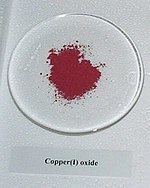Appearance brownish-red solid Molar mass 143.09 g/mol | Formula Cu2O Density 6 g/cm³ | |
 | ||
Copper(I) oxide or cuprous oxide is the inorganic compound with the formula Cu2O. It is one of the principal oxides of copper, the other being CuO or cupric oxide. This red-coloured solid is a component of some antifouling paints. The compound can appear either yellow or red, depending on the size of the particles. Copper(I) oxide is found as the reddish mineral cuprite.
Contents
Preparation
Copper(I) oxide may be produced by several methods. Most straightforwardly, it arises via the oxidation of copper metal:
4 Cu + O2 → 2 Cu2OAdditives such as water and acids affect the rate of this process as well as the further oxidation to copper(II) oxides. It is also produced commercially by reduction of copper(II) solutions with sulfur dioxide. Aqueous cuprous chloride solutions react with base to give the same material. In all cases, the color is highly sensitive to the procedural details.
Formation of copper(I) oxide is the basis of the Fehling's test and Benedict's test for reducing sugars. These sugars reduce an alkaline solution of a copper(II) salt, giving a bright red precipitate of Cu2O.
It forms on silver-plated copper parts exposed to moisture when the silver layer is porous or damaged. This kind of corrosion is known as red plague.
Little evidence exists for cuprous hydroxide, which is expected to rapidly undergo dehydration. A similar situation applies to the hydroxides of gold(I) and silver(I).
Properties
The solid is diamagnetic. In terms of their coordination spheres, copper centres are 2-coordinated and the oxides are tetrahedral. The structure thus resembles in some sense the main polymorphs of SiO2, and both structures feature interpenetrated lattices.
Copper(I) oxide dissolves in concentrated ammonia solution to form the colourless complex [Cu(NH3)2]+, which is easily oxidized in air to the blue [Cu(NH3)4(H2O)2]2+. It dissolves in hydrochloric acid to give solutions of CuCl2−. Dilute sulfuric acid and nitric acid produce copper(II) sulfate and copper(II) nitrate, respectively.
Cu2O degrades to copper(II) oxide in moist air.
Structure
Cu2O crystallizes in a cubic structure with a lattice constant al=4.2696 Å. The Cu atoms arrange in a fcc sublattice, the O atoms in a bcc sublattice. One sublattice is shifted by a quarter of the body diagonal. The space group is
Semiconducting properties
In the history of semiconductor physics, Cu2O is one of the most studied materials, and many experimental observations and semiconductor applications have been demonstrated first in this material:
The lowest excitons in Cu2O are extremely long lived; absorption lineshapes have been demonstrated with neV linewidths, which is the narrowest bulk exciton resonance ever observed. The associated quadrupole polaritons have low group velocity approaching the speed of sound. Thus, light moves almost as slowly as sound in this medium, which results in high polariton densities. Another unusual feature of the ground state excitons is that all primary scattering mechanisms are known quantitatively. Cu2O was the first substance where an entirely parameter-free model of absorption linewidth broadening by temperature could be established, allowing the corresponding absorption coefficient to be deduced. It can be shown using Cu2O that the Kramers–Kronig relations do not apply to polaritons.
Applications
Cuprous oxide is commonly used as a pigment, a fungicide, and an antifouling agent for marine paints. Rectifier diodes based on this material have been used industrially as early as 1924, long before silicon became the standard. Copper(I) oxide is also responsible for the pink color in a positive Benedict's Test.
